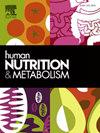使用明治营养分析系统评估饮食质量与日本成年人和老年人血清25-羟基维生素D水平之间的关系:来自NILS-LSA的横断面研究
IF 1.8
Q3 ENDOCRINOLOGY & METABOLISM
引用次数: 0
摘要
血清25-羟基维生素D (25OHVD)不足是全球公认的公共卫生营养问题。在日本人群中,饮食因素与血清25OHVD水平之间的关系尚不清楚。目的采用明治营养分析系统(Meiji NPS)评价日本中老年人群的饮食质量,并探讨其与血清25OHVD水平的横断面相关性。方法对参加日本国家长寿科学研究所-老龄化纵向研究的1272名中年人和873名老年人的数据进行分析。参与者有完整的饮食记录和血清25OHVD测量。采用明治NPS评价日粮质量,并计算个体日粮指数。饮食质量与血清25OHVD水平之间的关系采用校正各种协变量的一般线性模型进行检验。结果成人年龄中位数为53岁,饮食指数中位数为10.1分,血清25OHVD不足(30 ng/ml)发生率为74.2%;老年人年龄中位数为73.0岁,饮食指数中位数为12.0分,血清25OHVD不足发生率为60.5%。较高的饮食指数与成人血清25OHVD水平呈正相关(部分回归系数0.11;95%置信区间:0.04-0.18),老年人(0.17,0.07-0.26)。结论本研究提示明治NPS评估的饮食质量与中老年人群血清25OHVD水平呈正相关。本文章由计算机程序翻译,如有差异,请以英文原文为准。
Association between diet quality evaluated using the Meiji nutritional profiling system and serum 25-hydroxyvitamin D levels in Japanese adults and older adults: A cross-sectional study from the NILS-LSA
Background
The serum 25-hydroxyvitamin D (25OHVD) insufficiency is a recognized public health nutrition concern globally. The relationship between dietary factors and serum 25OHVD levels remains unclear in the Japanese population.
Objective
This study aimed to evaluate diet quality using the Meiji Nutritional Profiling System (Meiji NPS) and investigated its cross-sectional association with serum 25OHVD levels in Japanese middle-aged and older adults.
Methods
Data were analyzed from 1272 middle-aged adults and 873 older adults participating in the National Institute for Longevity Sciences - Longitudinal Study of Aging in Japan. Participants with complete dietary records and serum 25OHVD measurements were included. Diet quality was assessed using the Meiji NPS, and a dietary index was calculated for each individual. Associations between diet quality and serum 25OHVD levels were examined using general linear model adjusted for various covariates.
Results
The median age, dietary index, and prevalence of serum 25OHVD insufficiency (<30 ng/ml) were 53 years, 10.1 points, and 74.2 % in adults, and 73.0 years, 12.0 points, and 60.5 % in older adults, respectively. Higher dietary indices were positively associated with serum 25OHVD levels in both adults (partial regression coefficient 0.11; 95 % confidence interval: 0.04–0.18), and older adults (0.17, 0.07–0.26).
Conclusions
This study suggests a positive association between diet quality, as evaluated by the Meiji NPS, and serum 25OHVD levels in middle-aged and older adults.
求助全文
通过发布文献求助,成功后即可免费获取论文全文。
去求助
来源期刊

Human Nutrition and Metabolism
Agricultural and Biological Sciences-Food Science
CiteScore
1.50
自引率
0.00%
发文量
30
审稿时长
188 days
 求助内容:
求助内容: 应助结果提醒方式:
应助结果提醒方式:


